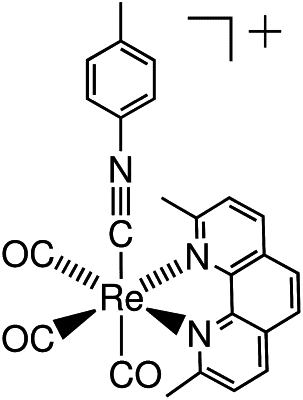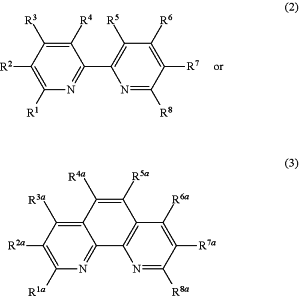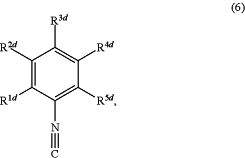| CPC C07F 13/00 (2013.01) [A61P 35/00 (2018.01)] | 22 Claims |

|
1. A composition comprising a rhenium(I) complex having the following structure:
 wherein
Re represents a rhenium ion having a +1 charge;
 represents an uncharged bidentate ligand of one of the following structures
 wherein R1, R2, R3, R4, R5, R6, R7, R8, R1a, R2a, R3a, R4a, R5a, R6a, R7a, and R8a are each independently selected from the group consisting of hydrogen atoms; hydrocarbon groups (R′) containing 1-6 carbon atoms; —ORa groups; —C(O)ORa groups; —OC(O)Ra groups; —C(O)Ra groups; and halogen atoms, wherein said hydrocarbon groups (R′) optionally include one or more heteroatoms selected from oxygen, nitrogen, and sulfur, and Ra is independently selected from hydrogen atoms and hydrocarbon groups (R′); and
L1 is an isonitrile ligand of the formula CN-R wherein R is an isonitrile ligand having the following structure:
 wherein R1d and R5d are hydrogen; and R2d, R3d, and R4d are independently selected from hydrogen atoms, hydrocarbon groups (R′) containing 1-6 carbon atoms, —OR″ groups, —C(O)OR″ groups, —OC(O)R″ groups, —C(O)R″ groups, —NR″2 groups, —C(O)NR″2 groups, —NR″C(O)R″ groups, halogen atoms, —CN groups, and nitro groups; wherein the hydrocarbon groups (R′) optionally include one or more heteroatoms selected from oxygen, nitrogen, and sulfur; and R″ is independently selected from hydrogen atoms and hydrocarbon groups (R′);
L2, L3, and L4 are each independently CO; and
X31 represents a non-coordinating monovalent anion.
|